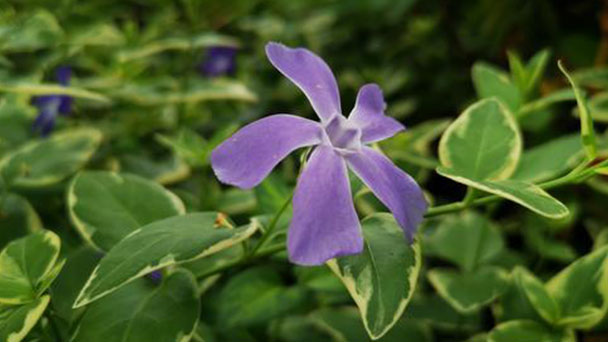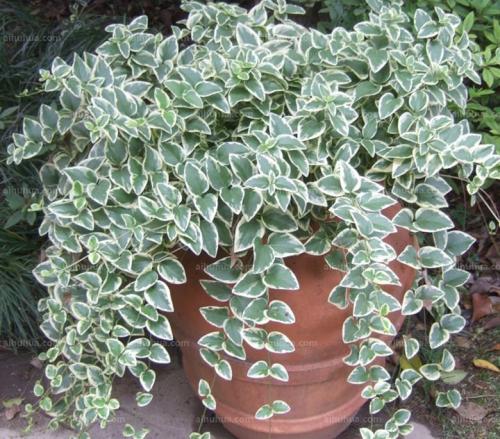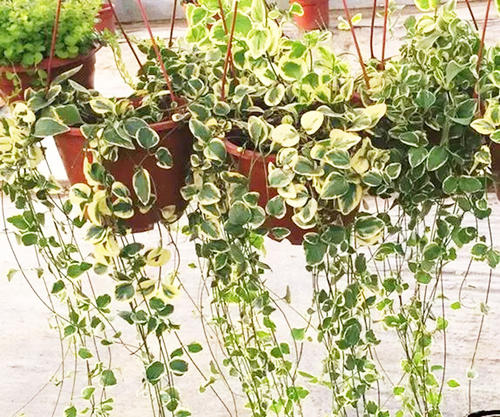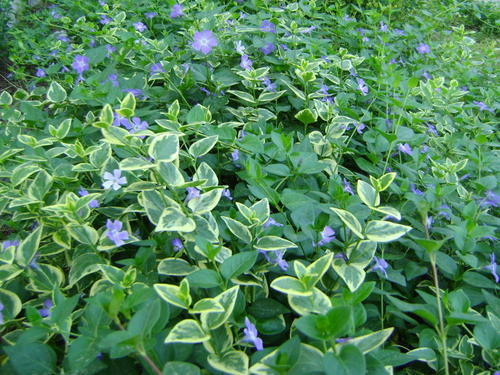Bigleaf periwinkle profile
Written by Maggie
Mar 16 2021

Bigleaf periwinkle, scientific name Vinca major, is a variety of the genus Vinca in the Oleander family. Bigleaf Periwinkle can be found in Jiangsu and other places in mainland China. It is short, crevellous and grows more than 2 meters long. Leaves are elliptic, opposite, petiolate, bright green, shiny, creamy yellow margin. Leaves of Bigleaf periwinkle are margin white with yellowish-white spots. Bigleaf periwinkle is cultivated in Jiangsu, Fujian, Guangxi, Guangdong, Hubei, Hunan and other provinces.
Bigleaf periwinkle picture
Morphological characteristics of bigleaf periwinkle
Bigleaf periwinkle (Vinca major) is a semi-shrubs of tendril, stems recumbent, flower stems erect; The leaf margin, petiole, calyx and throat of corolla are hairy, but others are glabrous. Leaves of bigleaf periwinkle are elliptic, margin white, with yellow-white spots, 2-6 cm long, 1.5-4 cm wide, apex acute, base descending; Lateral veins ca. 4 pairs; Petiole of Bigleaf periwinkle is 1 cm long. Flowers are solitary axillary; Pedicels are 4-5 cm long; Calyx lobes of Bigleaf periwinkle are narrowly lanceolate, 9 mm long; Corolla is blue, corolla tube funnel-shaped, corolla lobes obovate, 12 x 7 mm, apex rounded; Stamens are born below middle of corolla tube, filaments short and flat, anther apex hairy; The ovary consists of two carpels. Follicles ca. is 5 cm long.
Bigleaf periwinkle distribution range
Bigleaf periwinkle (Vinca major) is native to Europe and other places. It is cultivated in Jiangsu, Yunnan and other regions of China.
Bigleaf periwinkle growing environment
Bigleaf periwinkle (Vinca major) likes a warm and humid environment, more cold, like half shade environments.
Bigleaf periwinkle propagation methods
Bigleaf periwinkle division propagation
Bigleaf periwinkle (Vinca major) division propagation should be carried out in spring. Cut off the old branches of the previous year at this time, dig out the plants and separate, separate planting, pouring can be permeable.
Bigleaf periwinkle cutting propagation
Bigleaf periwinkle (Vinca major) cutting propagation can be propagated throughout the year. Cutting substrate with good water-retaining performance of perlite, vermiculite or sand (growing season). Autumn, winter cutting, should be carried out in the greenhouse or sun beds; In winter, the rooting rate is higher when the cutting is made on an electric hot bed in the greenhouse. Cutting cost in the greenhouse is too high, to obtain a large number of plants, should choose the growing season outdoor cutting bed cutting. Selected growth of robust, substantial branches of Bigleaf periwinkle as cuttings, cuttings length should be determined according to the season, winter should be long, about 10-13cm; Summer temperature is high, water evaporation is large, cuttings should not be too long, about 8-10cm (2-3 nodes). The upper part of the 2 leaves of Bigleaf periwinkle, cut to the root of the section, buried in perlite or sand, pouring permeable. Cutting for Bigleaf periwinkle propagation must have 1-2 sections buried in the river sand soil, and to be pressed and patted, timely watering moisturizing. In order to reduce leaf transpiration and prevent leaf wilting, when the summer light is strong, the shading net of 30%-50% shading rate can be put on the top of the cutting seedbed, shading is about 20 days or so, or the cutting under the shade. After the young seedlings of Bigleaf periwinkle start to take root, remove the shading net, control moisture, increase sunlight. Rooted Bigleaf periwinkle should be transplanted in time, planting each basin or each cluster of 3-4 plants, so that the formation of fast, high ornamental value. If late autumn transplants in the outdoor nursery, winter should take cold measures, such as covering sawdust, grass tomakomai, etc.

Bigleaf periwinkle growing methods
The environment
Bigleaf periwinkle (Vinca major) flowers like warm and sunny environments. They are also tolerant to shade, cold and drought, but the yellow patches of leaves become lighter in shade and are best planted in sparse forests.
Soil
Bigleaf periwinkle (Vinca major) prefers more fertile, moist soil. The cultivation of Bigleaf periwinkle requires loose sandy loam with rich humus, and the mixture of leaf rot soil garden and river sand can be used as the substrate for potting.
Watering
Drought should be watered, pay attention to drainage in the rainy season. Because of Bigleaf periwinkle fast growth, growth period to fully watering, keep the basin soil moist and moist, at the same time every month 1-3 times of liquid fertilizer, in order to ensure rapid growth of branches and tendrils and leaf color dark green bright. Bigleaf periwinkle is suitable for bright environments. But in the summer to avoid direct light, so as not to burn leaves; Shading must be appropriate, with the best semi-shade environment.
Plant diseases and insect pests of Bigleaf periwinkle
Blight disease, canker disease and leaf spot disease often occur, which can be controlled by spraying equal amounts of Bordeaux liquid. The insect pests of Bigleaf periwinkle were scale insects and root verrucosis. The scale insects were sprayed with 25% thiophos emulsified solution 1000 times, while the root verrucous were controlled with 3% carbofuran granules.
Bigleaf periwinkle value
The Bigleaf Periwinkle (Vinca major) is both heat-resistant and cold-resistant, evergreen and has a strong vitality, making it an ideal ground cover. And Bigleaf periwinkle flower color is gorgeous, the leaf shape is unique, and has a high ornamental value.

Latest Updated
- Benefits of Bugleweed - 7 Science-backed Health Benefits
- Bugleweed Dangers & Side Effects - Is It Poisonous?
- How to Plant Evergreen Trees - What You Should Know
- When to Plant Evergreens - Grow Guide for Evergreen Trees
- 12 Wonderful Evergreen Shrubs for Your Garden
- 12 Popular Evergreen Plants with Pictures for Beginners
- When And How To Prune A Lilac Bush Like a Pro
- How to Grow & Care for Lilac Vine (Hardenbergia Violacea)
- Japanese Lilac Tree (Syringa Reticulata) Care & Propagation Guide
- Shumard Oak Pros and Cons - What to Know
Popular Articles
- Winter maintenance of Antirrhinum Majus
- How to Grow Terminalia Mantaly Tree
- How to Grow and Care for Crossostephium Chinense
- How to grow Antirrhinum Majus in spring
- Peristeria Elata (Dove Orchid) Profile: Info & Care Guide
- Underwatered Snake Plant (Sansevieria Trifasciata) - Signs And How To Fix
- How to Care for Brazilian Jasmine Plant (Mandevilla Sanderi)
- How to Grow & Care for Graptopetalum Purple Delight in Summer
- Rosa Chinensis (China Rose): Plant Growing & Care Tips
- How to Care for Baby Sun Rose (Aptenia Cordifolia)
